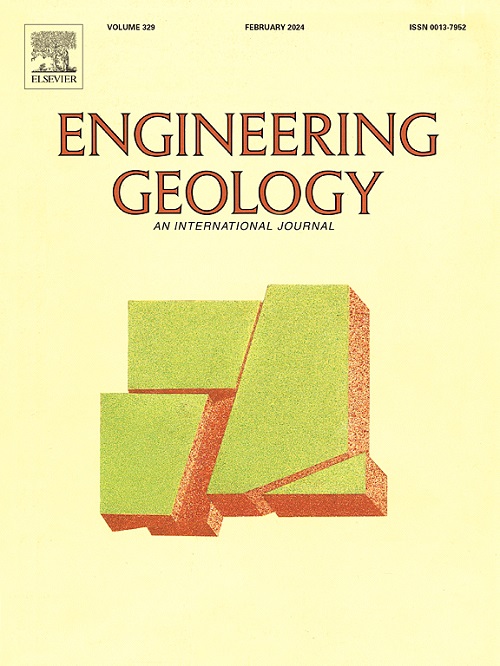Temporal stability and risk analysis of soil slopes subject to rainfall: The influence of heterogeneity
IF 6.9
1区 工程技术
Q1 ENGINEERING, GEOLOGICAL
引用次数: 0
Abstract
Evaluating the temporal stability and risk of unsaturated soil slopes during rainfall is essential for early warning and emergency response to landslides. However, limited research has been conducted on the transition timing of sliding mechanisms, instability/failure time and the integration of sliding consequences into quantitative risk assessment. In order to extend the research in this field, the Random Finite Element Method (RFEM) is used in this paper to investigate the influence of spatial variability of hydraulic properties (related to the fundamental parameter porosity) on the temporal stability and risk of soil slopes subject to rainfall. The findings indicate that the advancing speed of the wetting front is more rapidly in zones with low porosity than that in zones with high porosity. As rainfall progresses, the sliding mechanism of the slope shifts from deep sliding to shallow sliding. The homogeneous case tends to underestimate the rise in groundwater levels, leading to an overestimation of slope stability. Hydraulic boundary conditions significantly affect slope stability, making it crucial to consider horizontal (or near the toe of the slope) drainage conditions in practical applications. Additionally, the time of instability/failure predicted in the homogeneous case may be delayed compared to the actual conditions. Both probability of instability/failure and risk increase with continued rainfall. Compared to scenarios where the spatial variability of internal friction angle is not considered, the probability of instability/failure and risk will be higher when the spatial variability of internal friction angle is additionally considered. Risk-based assessment can define the risk levels, reflecting the severity of sliding consequences. Furthermore, the Malin slope failure record from the Chibo region of India is used to validate the effectiveness of the proposed approach. The probabilities of slope failure align well with actual observations, and the risk-based assessment provides additional information into the Malin landslide. This paper proposes a general model for studying the performance of heterogeneous slopes subject to rainfall, providing valuable guidance for landslide early warning systems and the scope and timing of emergency measures taken.
求助全文
约1分钟内获得全文
求助全文
来源期刊

Engineering Geology
地学-地球科学综合
CiteScore
13.70
自引率
12.20%
发文量
327
审稿时长
5.6 months
期刊介绍:
Engineering Geology, an international interdisciplinary journal, serves as a bridge between earth sciences and engineering, focusing on geological and geotechnical engineering. It welcomes studies with relevance to engineering, environmental concerns, and safety, catering to engineering geologists with backgrounds in geology or civil/mining engineering. Topics include applied geomorphology, structural geology, geophysics, geochemistry, environmental geology, hydrogeology, land use planning, natural hazards, remote sensing, soil and rock mechanics, and applied geotechnical engineering. The journal provides a platform for research at the intersection of geology and engineering disciplines.
 求助内容:
求助内容: 应助结果提醒方式:
应助结果提醒方式:


